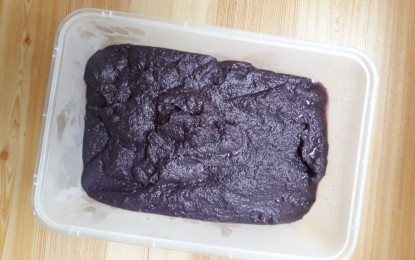
(File photo)
MANILA – While physical reunions and gatherings for the holiday season are put on hold, not even a pandemic could stop the holidays, which also means a season of eating for many Filipinos.
At the stroke of midnight on Thursday, Filipino families would welcome another year by trooping to the dining table for the “media noche”, which would be incomplete without a sumptuous dessert.
In the Philippines, one of the delicacies that complete the holiday feast of families is the delicious and sticky "halayang ube" (purple yam).
But more than just a sweet treat, many Filipinos have considered this as a part of their family heritage that binds them together.
Jeca Marie Curammeng, 27, a long-time resident of Malabon City, said cooking "halayang ube" has been a long-time holiday tradition of their family.
"Tradisyon na kasi ng pamilya namin na magluto at mamigay ng 'halaya' tuwing Pasko. Parang hindi kumpleto yung okasyon kapag wala siya (It is a tradition of our family to cook and give 'halaya’ during the Christmas season. The festivities won't be complete without it)," Curammeng said in an interview with the Philippine News Agency (PNA) on Monday.
She said the tradition was passed down to them by her late grandfather, Armando Fernandez Sr., who religiously cooked "halaya" throughout his life.
"Si Lolo nga daw, sabi ni Nanay, mga first week pa lang ng December nagluluto, at katulong nya sa paghalo yung mga mas matatanda niyang apo (My grandfather, according to my mother, is known to cook 'halaya' starting the first week of December. Helping with the task of stirring the mixture are his older grandchildren)," Curammeng added.
Walter Lopez, 43, also a resident of Malabon, said receiving "halayang ube" from friends and loved ones means a lot.
"Sobrang feeling privileged pag nabigyan or nakatanggap ako, lalo't nalaman ko kung gaano kahirap gawin 'yun (I feel very privileged every time I receive 'halaya' during the holidays, knowing how much work goes into cooking it)," Lopez said.
Before one can savor its sweetness and chunky texture, "halayang ube" is cooked arduously for three to four hours with the cooks getting splattered and scalded with the mixture as they cook it over a charcoal or wood fire or in the much modern gas stove.
The ingredients of this all-time favorite consist of purple yam, white sugar, cheddar cheese, margarine, eggs, coconut milk, and cans of condensed milk.
It is made by peeling and boiling the yam until it is soft like rice porridge.
When the yam reaches that consistency, the mixture is left to cool before it is mashed using a spatula to make it softer and easier to mix along with other ingredients.
Depending on the cook, mixing can take as little as 10 minutes or as long as 30 minutes for the traditionalist who wants all ingredients to blend properly.
Once this is done, the mixture is placed on a huge basin-like container atop a fire fed by charcoal, coconut husk or dried wood.
The mixture would then be transferred to llaneras (aluminum oval containers) where they are left to cool down to room temperature.
After this tedious procedure, the “halayang ube” is stored in the refrigerator, ready to be presented to the family and guests during the "noche buena" and "media noche" feasts or distributed as gifts during Christmas or New Year's Day reunions or get-togethers. (PNA)
